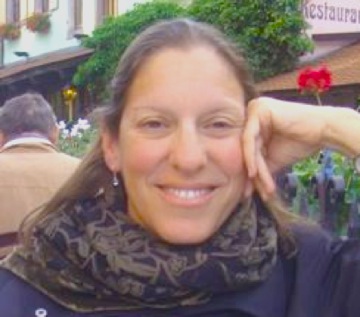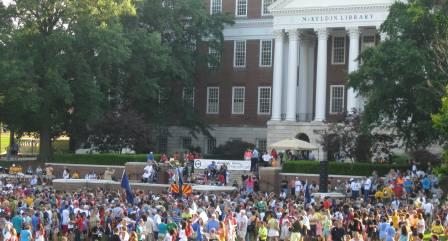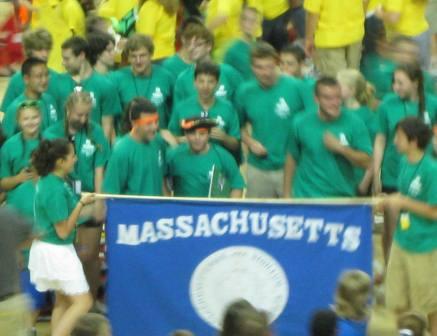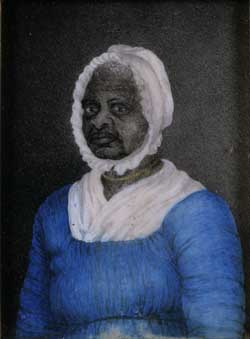By Elaine Grublin & Kate Veins
Each year the MHS grants a number of research fellowships to scholars from around the country. For more information about the different fellowship types, click the headings below.
Our fellowship programs bring a wide variety of researchers working on a full range of topics into the MHS. If any of the research topics are particularly interesting to you, keep an eye on our events calendar. All research fellows present at brown-bag lunch programs as part of their commitment to the MHS.
MHS Short-term Fellowships
African-American Studies Fellowship
Heather Cooper, University of Iowa
“Representing the Race: African American Performances of Slavery and Freedom in the Nineteenth Century”
Alumni Fellowship
Lauri Coleman, William and Mary
“Interpretations of New England Weather in the Revolutionary Era”
Andrew Oliver Fellowship
Katelyn Crawford, University of Virginia
“Mobility and Portrait Painting in the Late Eighteenth-Century British Atlantic World”
Andrew W. Mellon Fellowship
Frances Clarke, University of Sydney
“Minors in the Military: A History of Child Soldiers in America from the Revolution to the Civil War”
Eberhard Faber, Princeton University
“‘Everybody Talks of Visiting That Country’: New England Reactions to the Louisiana Purchase, Territorial Rule, and Louisiana Statehood, 1803-1812”
Michael Hevel, University of Iowa
“‘Betwixt Brewings’: A History of College Students and Alcohol”
Ann K. Johnson, University of Southern California
“Cabinets of Miscellany and Meaning: Managing Information in Antebellum America”
Greta LaFleur, University of Hawai’I at Manoa
“American Insides: Popular Narrative and the Historiography of Sexuality, 1675-1815”
Jen Manion, Connecticut College
“Crossing Gender; Female Masculinity in the 18th and 19th Centuries”
Brooke Newman, Virginia Commonwealth University
“Island Masters: Gender, Race, and Power in the Eighteenth-Century British Caribbean”
Benjamin Park, University of Cambridge
“Localized Nationalisms in Post-Revolutionary America”
Brad Snyder, University of Wisconsin
“The House of Truth: The Men Who Created Modern Progressivism”
Benjamin F. Stevens Fellowship
Sarah Sutton, Brandeis University
“Industrializing the Family Farm: Dairy Farming, Milk Consumption, and the New England Landscape”
Cushing Academy Fellowship in Environmental History
Jennifer Staver, University of California Irvine
“Energy, Work, and Power along the Pacific Coast of North America, 1768 to 1820”
Malcolm and Mildred Freiberg Fellowship
Katherine Grandjean, Wellesley College
“‘Terror ubique tremor’: Communicating Terror in Early New England, 1677-1713”
Marc Friedlaender Fellowship
Rick Kennedy, Point Loma Nazarene University
“Cotton Mather Biblia Americana Volume 8”
Massachusetts Society of the Cincinnati Fellowship
Holger Hoock, University of Pittsburgh
“Scars of Independence: Practices and Representations of Violence in the American Revolutionary War”
Ruth R. & Alyson R. Miller Fellowship
Bonnie Lucero, University of North Carolina Chapel Hill
“Privates, Prostitutes, and Pardos: Women and Racial Conflict in Cienfuegos, Cuba, circa 1898”
Lindsay Moore, Boston University
“Women, Power, and Litigation in the English Atlantic World, 1630-1700”
W. B. H. Dowse Fellowship
Nichole George, University of Notre Dame
“Riots and Remembrance: America’s Idols and the Origins of American Nationalism”
Reiner Smolinski, Georgia State University
“Cotton Mather: The Life of a Puritan Intellectual”
Suzanne and Caleb Loring Fellowship
Ann K. Holder, Pratt Institute
“‘Making the Body Politic’: Sexual Histories, Racial Uncertainties and Vernacular Citizenship in the Post-Emancipation U.S.”
MHS-NEH Long-term Fellowships
Megan Bowman, University of California Santa Barbara
“Networking for Global Perfection: The International Dimension of Nineteenth-Century Fourierism”
Kristen Collins, Boston University School of Law
“Entitling Marriage: A History of Marriage, Public Money, and the Law”
Matthew Dennis, University of Oregon
“American Relics and the Material Politics of Public Memory”
Martha Hodes, New York University
“Mourning Lincoln: Personal Grief and the Meaning of the American Civil War”
New England Regional Fellowship Consortium Fellows
*Denotes scholars whose itineraries include the MHS
Kelly Brennan Arehart, College of William and Mary
“Give Up Your Dead: How Business, Technology, and Culture Separated Americans from their Dearly Departed, 1780-1930”
Justin Clark, University of Southern California*
“Training the Eyes: Romantic Vision and Class Formation in Boston, 1830-1870”
Michael Cohen, Tulane University
“Jews in the Cotton Industry: Ethnic Networks in 19th Century America”
John Dixon, Harvard University*
“Found at Sea: Mapping Ships’ Locations on the Eighteenth-Century Atlantic”
Moira Gillis, University of Oxford*
“The Unique Early Modern American Corporation”
Jared Hardesty, Boston College*
“The Origins of Black Boston, 1700-1775”
Benjamin Hicklin, University of Michigan Ann Arbor*
“‘Neither a Borrower nor a Lender Be’?: The Experience of Credit and Debt in the English Atlantic World, 1660-1750”
Allison Lange, Brandeis University*
“Pictures of Change: Transformative Images of Woman Suffrage, 1776-1920”
Jason Newton, Syracuse University
“Forging Titans: Myth and Masculinity in the Working Forests of the American Northeast, 1880-1920”
Ana Stevenson, University of Queensland*
“The Woman-Slave Analogy: Rhetorical Foundations in American Culture, 1830-1900”
Gloria Whiting, Harvard University
“‘Endearing Ties’: Black Family Life in Early New England”



 Martha Hodes
Martha Hodes
 I was fortunate enough to travel with the Massachusetts delegation to this year’s national competition. The festivities began on the evening of Sunday, June 10, with a rousing opening ceremony on the lawn at McKeldin Library. Imagine thousands of students, parents, and teachers cheering, chattering, and trading pins and you’ll have a good sense of what the opening ceremony was like. The competition got down to business on Monday morning, and while in College Park I had the opportunity to serve as a judge along with more than 300 other historians and other education professionals. Anyone who has ever judged at a history day competition can tell you what an amazing experience this is. I met with many talented and enthusiastic students over the course of the three-day competition. They taught me a great deal about topics as diverse as Levittown, the use of helicopters in the Vietnam War, and Nicola Tesla. Thanks to a very well illustrated project on Civil War hospitals, I also have new appreciation for modern medicine.
I was fortunate enough to travel with the Massachusetts delegation to this year’s national competition. The festivities began on the evening of Sunday, June 10, with a rousing opening ceremony on the lawn at McKeldin Library. Imagine thousands of students, parents, and teachers cheering, chattering, and trading pins and you’ll have a good sense of what the opening ceremony was like. The competition got down to business on Monday morning, and while in College Park I had the opportunity to serve as a judge along with more than 300 other historians and other education professionals. Anyone who has ever judged at a history day competition can tell you what an amazing experience this is. I met with many talented and enthusiastic students over the course of the three-day competition. They taught me a great deal about topics as diverse as Levittown, the use of helicopters in the Vietnam War, and Nicola Tesla. Thanks to a very well illustrated project on Civil War hospitals, I also have new appreciation for modern medicine. began with the best parade I’ve ever seen: a parade of participating students across the floor of the arena. I watched over 2,000 students circle the arena with everything from state flags to inflatable lobsters! Throughout the morning, dozens of students were singled out for awards and special prizes, and the boisterous crowd made sure that each winner was duly appreciated. Prizes were sponsored not only by NHD but by friends of history like the
began with the best parade I’ve ever seen: a parade of participating students across the floor of the arena. I watched over 2,000 students circle the arena with everything from state flags to inflatable lobsters! Throughout the morning, dozens of students were singled out for awards and special prizes, and the boisterous crowd made sure that each winner was duly appreciated. Prizes were sponsored not only by NHD but by friends of history like the 
 If you are interested in learning more about the end of slavery here in Massachusetts, visit our web feature
If you are interested in learning more about the end of slavery here in Massachusetts, visit our web feature